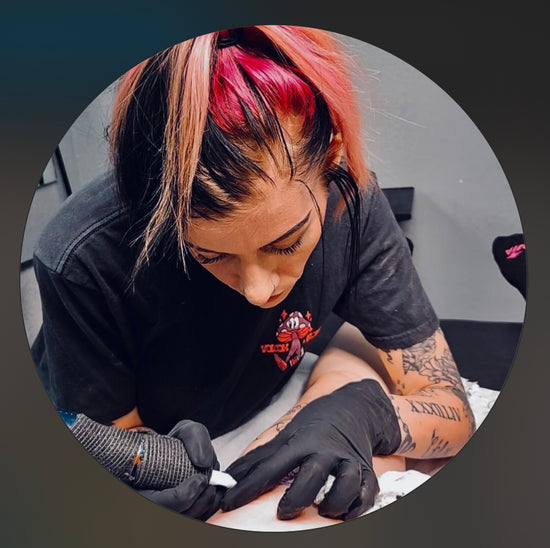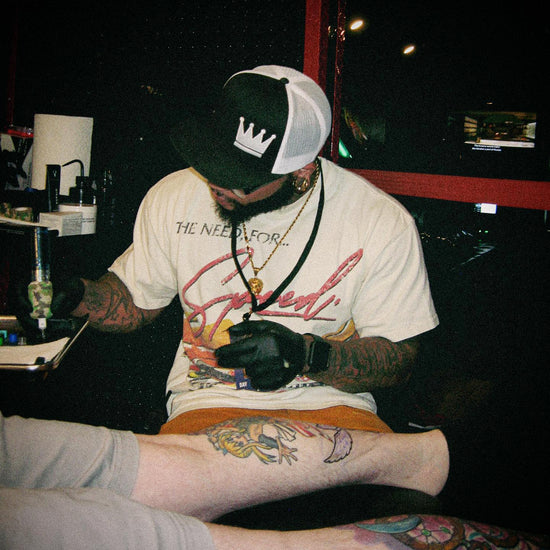THE CREW
Aftercare
-

Congratulations on your new tattoo! By following these simple instructions, the healing process should be quick and easy.
First Day/Night
Keep the bandage on for a minimum of 6 hours. We recommend keeping it on overnight provided the dressing feels comfortable and secure. If you decide to remove the bandage before going to sleep, follow the instructions in the next section to properly remove the bandage and clean your tattoo.
On your first night, there’s a chance your tattoo will still bleed. The blood can dry overnight and stick to your clothes or bedding. If this happens, gently take the fabric off. DO NOT force it off or be rough with it. If it still does not come off, wet the area with lukewarm water and gently slide it off.
Fresh tattoos sometimes “weep” during the first couple of days, meaning that plasma and ink form a thin moist coating on the skin. This can be DABBED with a clean paper towel. Press the paper towel to the skin and remove. Do not wipe the tattoo or be rough with it. Do not panic when you see the colors of the tattoo on the paper towel, or on your hands as you clean it. This is simply excess ink being secreted from the surface or the skin.
To avoid stains, use towels and bedsheets with darker tones and wear dark clothing
Taking off the Bandage and Cleaning Your Tattoo
Before you start, make sure your hands are clean and you have unscented antibacterial soap ready. Avoid soap with fragrance, moisture beads or scrubs.
Carefully remove the bandage and tape. If you feel the bandage sticking to the tattoo, wet it with lukewarm water and gently slide it off.Make a lather in your hands with soap and warm water. NO washcloths, bath towels, or sponges on a fresh tattoo. Gently clean the tattoo using a circular motion until all ointment and plasma are removed. Rinse the tattoo gently until the skin is clean. Pat dry with a clean towel or paper towel then allow to fully air dry for a minimum of 10 minutes. DO NOT SCRUB. Once the tattoo is dry, apply a very small amount of Aquaphor or Bacitracin. Gently rub the ointment into your tattoo. Dab any excess off with a clean paper towel.
Applying too much ointment can cause your tattoo to “suffocate.” Apply only a very thin coat so your tattoo can breathe.
Clean your tattoo this way once a day in the shower for the first 2-3 days.
There is no need to re-bandage the tattoo, but please be mindful that your tattoo is a wound and when unwrapped, it is prone to dirt and bacteria which may cause infection. Avoid direct contact with any surface.
Your Daily Tattoo Aftercare Routine
Apply the Aquaphor or Bacitracin 2-3 times a day (Remember, keep it light!) for the first 5-7 days or until your tattoo starts to flake/peel like a sunburn. When the peeling begins, switch to a regular FRAGRANCE FREE lotion such as Lubriderm, or any other fragrance free brand for an additional 2 weeks.
Your tattoo should be completely healed within 2-4 weeks.
If you have extremely sensitive skin, the lotion may cause breakouts. If this happens, just reduce the number of your daily lotion application.
After the first few days, your tattoo may become itchy or begin to form flaky scabs. They will fall off on their own, so DO NOT PICK OR SCRATCH AT YOUR TATTOO. Doing so can cause some of the pigment to disappear, and your tattoo may not heal properly. Keep it moisturized and the scabs will eventually dissipate.
Important Dos and Don’ts
Clean towels, bedding and clothes are highly recommended during the healing process.
Showering is fine, however, please DO NOT soak your tattoo for at least 2 weeks. This means no swimming, baths or submerging your tattoo in water for long periods of time.
Avoid direct sunlight on your tattoo for at least 2 weeks and your tattoo is completely healed. After that, we advise putting on a sunblock (minimum SPF 50) on your tattoo whenever you find yourself in direct sunlight for the rest of your life. The sun will undoubtedly cause damage and compromise the longevity of your tattoo.
Wear loose clothing (preferably cotton) and avoid constricting accessories like bra straps and tight waistbands over a fresh tattoo. Avoid dirty, sweaty or itchy clothing as they can create healing problems.
-

Congrats on your new tattoo! FOLLOW THESE INSTRUCTIONS IF YOUR ARTIST USED A RECOVERY DERM BANDAGE
Leave the Recovery Derm Shield on for 4-7 days as recommended by your artist. It will protect your tattoo during it's healing process. After the 4-7 days, gently peel away the Derm Shield back over itself. This will work best while under warm, running water. Once it has all been removed, wash your tattoo with unscented soap and warm water. Use unscented lotion for the remainder of the healing process.
-

Congrats on your new piercing!Follow these instructions for an easy healing process
WASH
your hands thoroughly prior to cleaning or touching your piercing for any reason.
SALINE
rinse as needed during healing. For certain placements it may be easier to apply using clean gauze saturated with saline solution. A brief rinse afterward will remove any residue.If your piercer suggests using soap, gently lather around the piercing and rinse as needed. Avoid using harsh soaps, or soaps with dyes, fragrances, or triclosan.
RINSE
thoroughly to remove all traces of the soap from the piercing. It is not necessary to rotate the jewelry through the piercing.
DRY
by gently patting with clean, disposable paper products because cloth towels can harbor bacteria and snag on jewelry, causing injury.
WHAT IS NORMAL?
Initially: some bleeding, localized swelling, tenderness, or bruising.During healing: some discoloration, itching, secretion of a whitish-yellow fluid (not pus) that will form some crust on the jewelry. The tissue may tighten around the jewelry as it heals.Once healed: the jewelry may not move freely in the piercing; do not force it. If you fail to include cleaning your piercing as part of your daily hygiene routine, normal but smelly bodily secretions may accumulate.A piercing may seem healed before the healing process is complete. This is because tissue heals from the outside in, and although it feels fine, the interior remains fragile. Be patient, and keep cleaning throughout the entire healing period.Even healed piercings can shrink or close in minutes after having been there for years! This varies from person to person; if you like your piercing, keep jewelry in—do not leave it empty.
WHAT TO DO
*Wash your hands prior to touching the piercing; leave it alone except when cleaning.
*During healing it is not necessary to rotate your jewelry
*Exercise during healing is fine; listen to your body.
*Make sure your bedding is washed and changed regularly. Wear clean, comfortable, breathable clothing that protects your piercing while you are sleeping.
*Showers tend to be safer than taking baths, as bathtubs can harbor bacteria. If you bathe in a tub, clean it well before each use and rinse off your piercing when you get out.
WHAT TO AVOID
*Avoid cleaning with alcohol, hydrogen peroxide, antibacterial soaps, iodine, or any harsh products, as these can damage cells. Also avoid ointments as they prevent necessary air circulation.
*Avoid Bactine®, pierced ear care solutions, and other products containing Benzalkonium Chloride (BZK). These can be irritating and are not intended for long-term wound care.
*Avoid over-cleaning. This can delay your healing and irritate your piercing.
*Avoid undue trauma such as friction from clothing, excessive motion of the area, playing with the jewelry, and vigorous cleaning. These activities can cause the formation of unsightly and uncomfortable scar tissue, migration, prolonged healing, and other complications.
*Avoid all oral contact, rough play, and contact with others’ bodily fluids on or near your piercing during healing.
*Avoid stress and recreational drug use, including excessive caffeine, nicotine, and alcohol.
*Avoid submerging the piercing in unhygienic bodies of water such as lakes, pools, hot tubs, etc. Or, protect your piercing using a waterproof wound sealant bandage. These are available at most drugstores and work best for nipple, navel, and surface piercing placements.
*Avoid all beauty and personal care products on or around the piercing including cosmetics, lotions, and sprays, etc. Don’t hang charms or any object from your jewelry until the piercing is fully healed.
*Sleeping directly on a healing cartilage piercing can cause irritation, even causing shifts in the piercing’s angle. Placing a travel pillow, on top of your pillow, and then placing your ear in the opening can be helpful to avoid this








